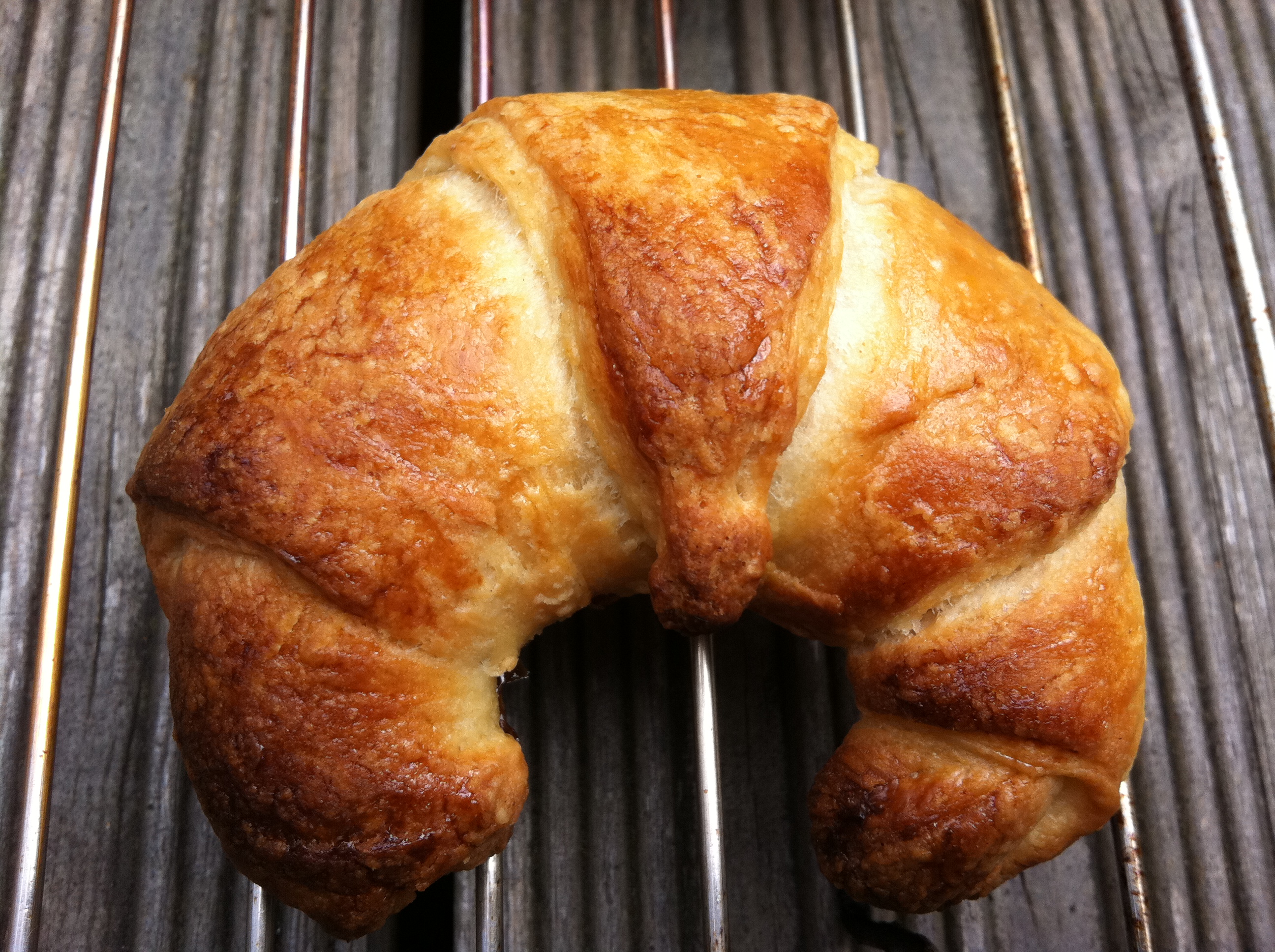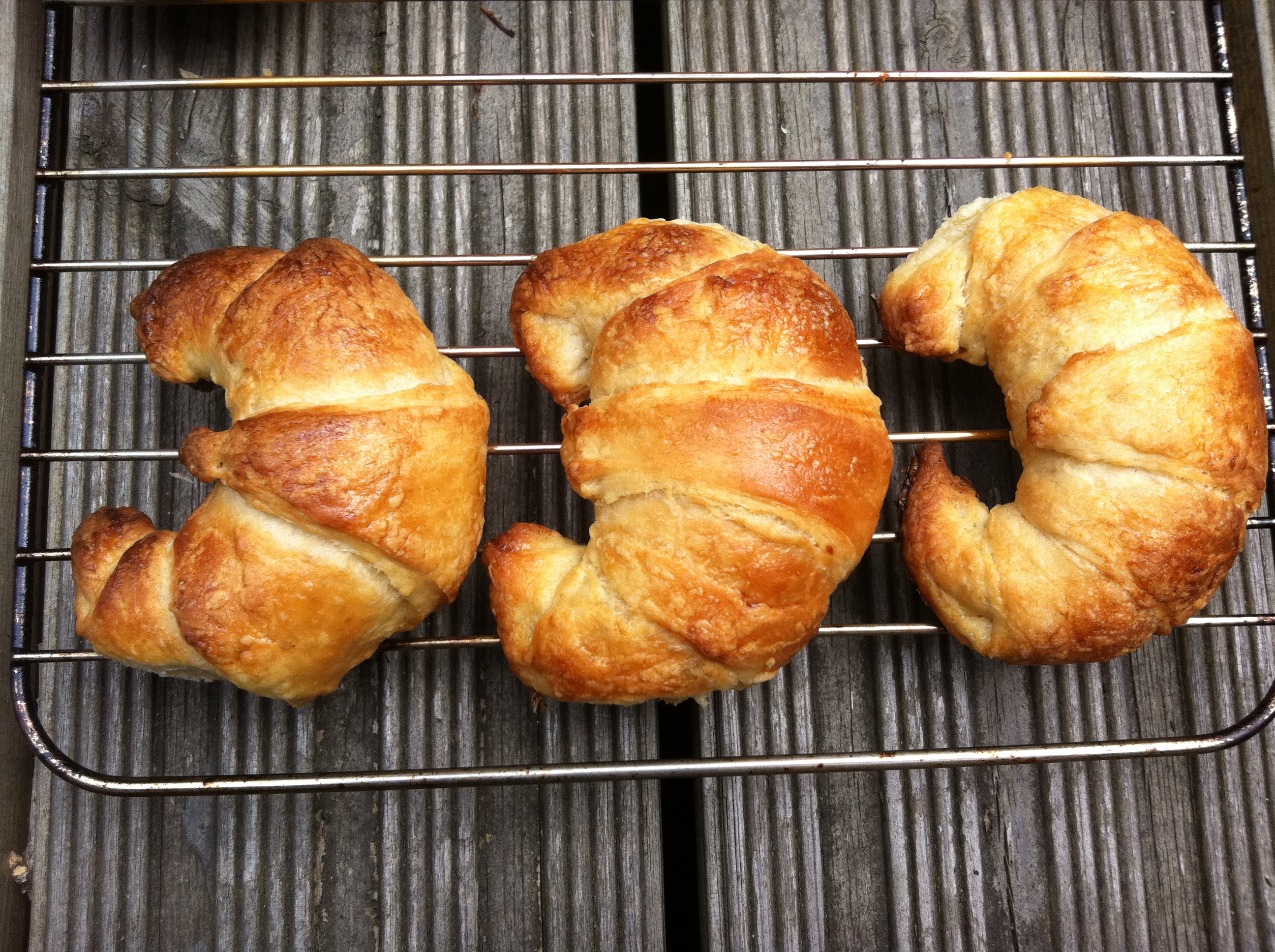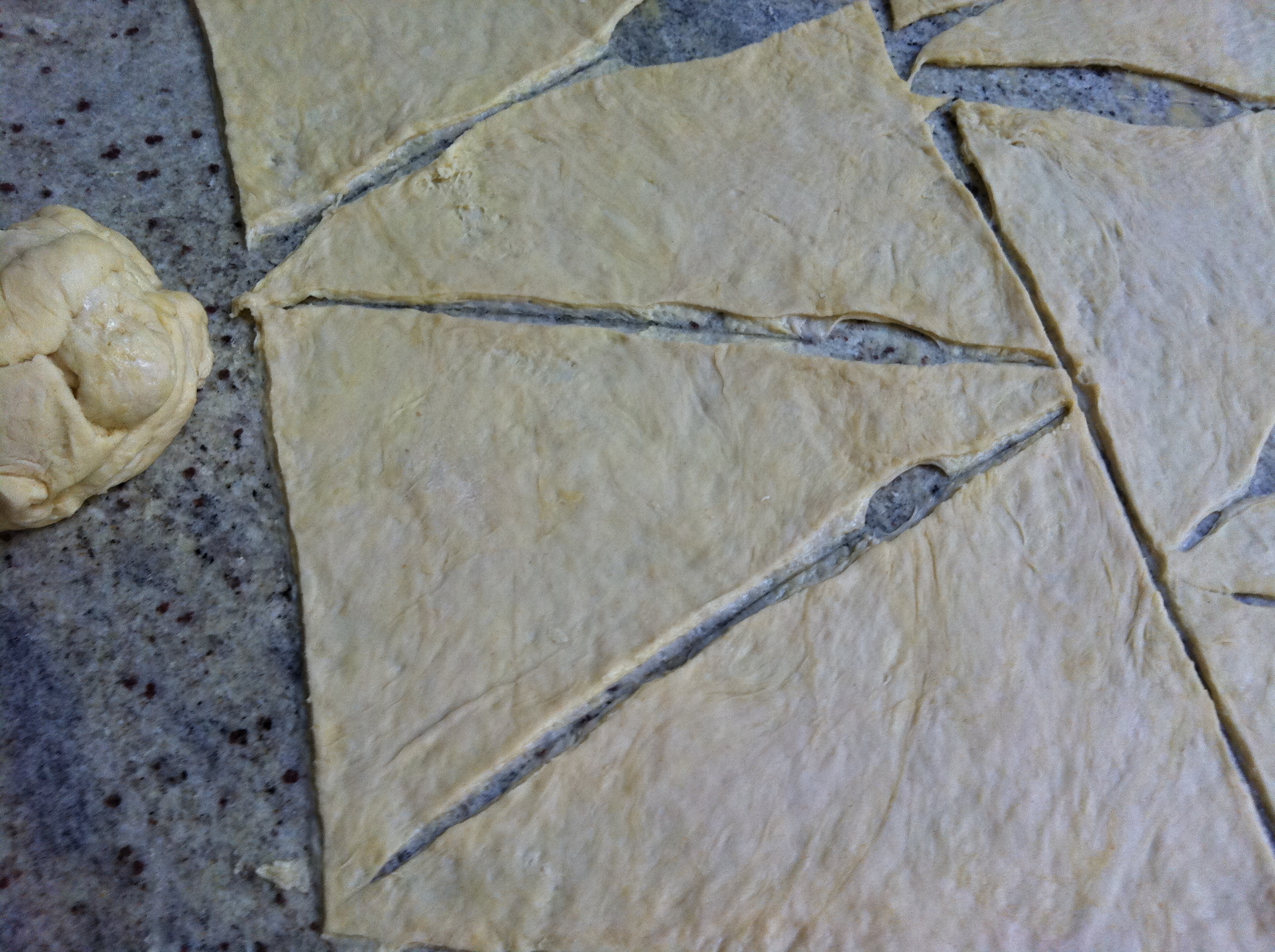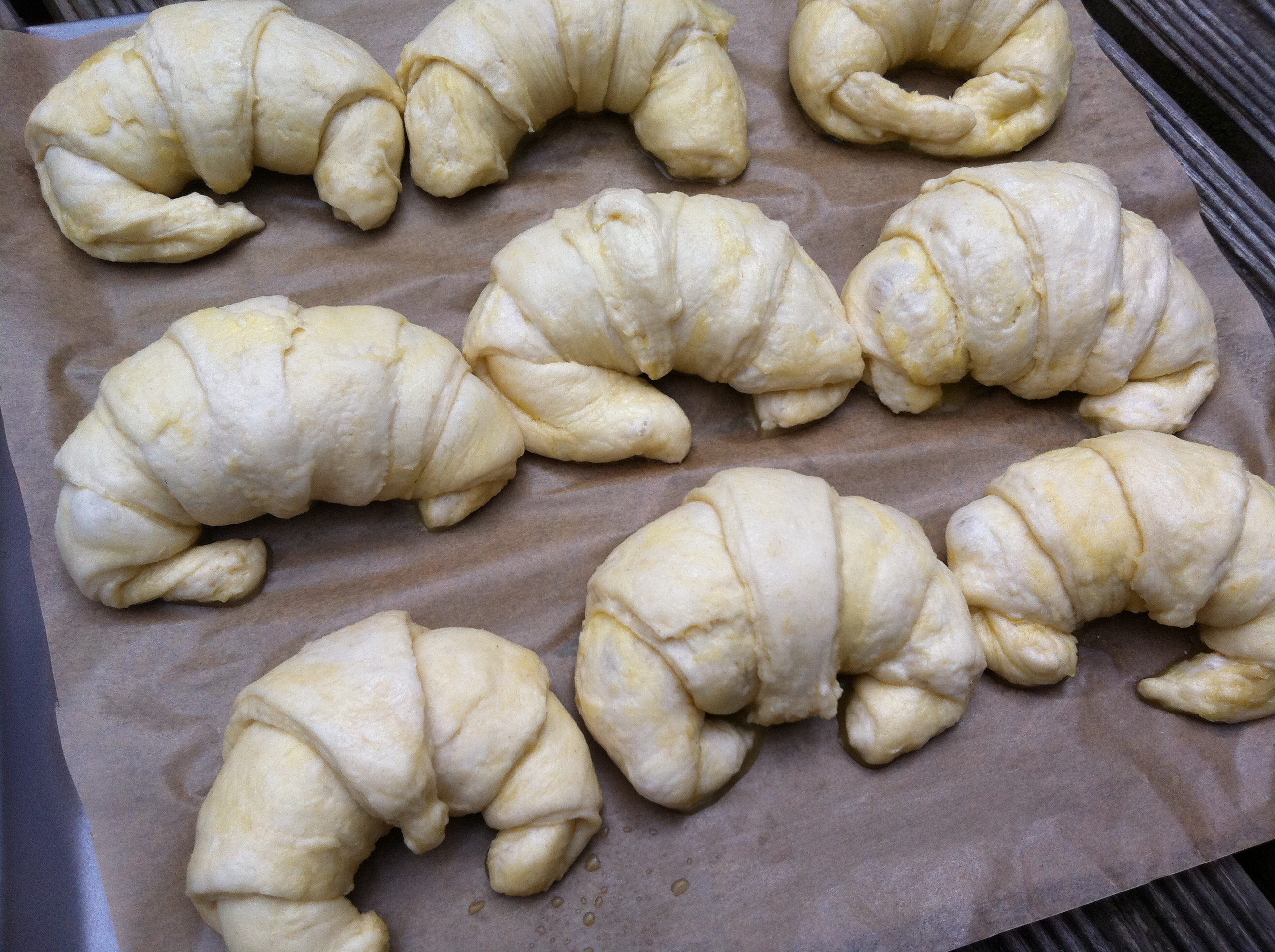‘It’s a labour of love’. ‘You’ll pile on the pounds’. ‘It’ll change the way you think about them forever’ . . .
You might be forgiven for thinking such comments are in some way related to pregnancy and children. They’re not. Despite being an avid baker, at only just the wrong side of twenty-five, I’m not quite ready for that kind of bun in the oven. Nope, I’m talking croissants.
Search for ‘homemade croissant’ online and you’ll find thousands of recipes, often accompanied by a caveat. Yes they are wonderful, and yes you’ll love the end product, but getting there is a tricky, time-consuming process and everyone seems to have a horror story to share (back to that pregnancy comparison, I think there might be some mileage in this . . .)
Not to mention the butter. Do you know how much butter goes into each individual croissant?
Well yes, quite a lot it seems. Ok, but probably no more than, say, the amount your favourite restaurant casually drops into the pan to finish that piece of beautiful fresh fish you ordered so virtuously. Warm, flaky, melt-in-your-mouth pastry doesn’t conjure itself up from plain old flour and water. This is indulgent French baking at its very best. My advice? Relax and enjoy.
My other piece of advice? It’s not as tricky as it seems. Making croissants is definitely time consuming – don’t think you can roll out of bed on a Sunday morning and pull these together in time for a lazy brunch – but the process is pretty simple and absolutely worth giving a go. The lengthy recipe below looks a little daunting at first, but stick with it. It’s adapted from my all time favourite bread book, The River Cottage Bread Handbook and the steps are both logical and easy to follow.
One word of warning – you’re unlikely to eat fewer than two croissants in one sitting when they emerge hot and flaky from the oven. I’d say a safer bet would be three or four (in my case, two normal, one chocolate – fairly restrained but I had just been out for brunch . . .). Of course these little beauties can be frozen, but once your friends and family smell the incredible buttery aromas wafting from the kitchen, you’re unlikely to need to.
Homemade all-butter croissants (adapted from The River Cottage Bread Handbook):
(makes 12 – 16)
500g strong white bread flour
10g salt
165ml warm water
165ml warm milk
5g dry powdered yeast
70g caster sugar
250g unsalted butter
For the glaze:
1 medium free range egg yolk
25ml milk
Chocolate shavings (optional)
Icing sugar (optional)
Croissant dough is soft, sticky and difficult to knead by hand, so if you can, use a mixer with a dough attachment for the first stage. Sadly my mixer is not quite sophisticated enough to mix dough without spontaneously combusting, so I mixed the ingredients briefly in my blender with a plastic paddle, then kneaded by hand for around 10 minutes. A little more hard work but pretty much the same results.
So, put all the ingredients (not including the butter) into a mixer bowl and fit the dough hook (or do it by hand as above). Knead on a medium to low speed until the dough is soft, stretchy and satiny – around 10 mins. Once the dough reaches this stage (by hand or by mixer), remove from the bowl, put inside a black plastic bin liner and, leaving some space (it needs to rise), suck out the air, tie a knot in the bag and pop it in the fridge to rest for a minimum of 6 hours.
When you are ready for the next stage, take your butter out of the fridge and allow to warm up slightly. It shouldn’t be soft – the idea is that dough and butter are about the same temperature to prevent the butter becoming greasy and splurging out of the final pastry.
When the butter is ready, lightly flour then lay it between two sheets of cling film and bat it with a rolling pin to form a neat, 1cm thick square. Put to one side, then take the dough out the fridge and roll out to a rectangle, a little more than double the size of the butter square. You then need to lay the butter on one half of the dough, then fold the other half over the top, pressing all round the edges to seal the butter in.
Next, roll the dough away from you until twice it’s original length, then fold the top and bottom edges in by one-sixth. Fold them in again by another sixth, so the folds meet in the middle, then fold one on top of the other.
Give the dough a quarter turn and roll out again to the same size as before. Fold the top and bottom edges in to meet at the middle, then fold one on top of the other. Roll this out slightly and seal the edges with the rolling pin.
Pop the dough back into the black plastic bag and return to the fridge to rest for an hour or so. I left mine overnight which allowed the gluten plenty of time to relax, and meant less of a workout for me the next morning!
Now it’s time to make your croissant template. Cut an isosceles triangle out of a piece of cardboard. Daniel Stevens recommends 20cm wide by 25cm tall and this makes a pretty standard size croissant – if you’re looking to make something a little more delicate, or a jumbo-sized whopper, adjust your triangle dimensions accordingly.
When the dough is rested and ready, unwrap and roll into a neat rectangle, approx. 70cm long and 50cm wide. If not exact, trim the rectangle to these measurements to ensure nice, neat croissants. Then, using your cardboard template as a guide, cut between 12 – 16 croissants from the dough (see below).
Lay each triangle with the tip pointing away from you, and roll up from the wide base. Wet the pointed end and seal it round the croissant. Curl the tips round to form a crescent (or you can leave straight), and pinch together to hold them in place. I made a combination of straight and pinched, and also made a couple of chocolate versions too (how could I resist!). For a chocolate variation, simply cut out a rectangle 10cm wide and 25cm high. Place a chocolate baton, or a few chocolate chips in a line down one edge, roll the dough over, lay down another line of chocolate then roll up into the standard rectangular shape you see in bakeries everywhere.
Lay your croissants, with the sealed point underneath, on baking trays lined with greased baking parchment. Cover with another black plastic bag and leave to rise until doubled in size – this could take a couple of hours or longer, depending on how cold your dough is.
When ready to bake, preheat the oven to 200 degrees C/Gas Mark 6. Beat the egg yolk and milk together and gently brush over the croissants. You could also sprinkle with chocolate flakes, if using, at this stage. Bake for about 10 minutes, then lower the setting to 170 degrees C/Gas Mark 3 and bake for a further 5 – 10 minutes until beautifully golden.
Transfer to a wire rack and cool every so slightly before getting stuck in! At this stage you could also sift a final dusting of icing sugar over the croissants for a sweet, feathery finish.












Lovely post, can’t believe how good those look, perfect!
Ah, thank you 🙂 I was really pleased how ‘real’ they look – didn’t think it would be possible to make them look like the ones you buy in patisseries!
OMG they look perfect. They’ve always scared me to make at home but I’d have a crack at them now.
I’m a bit sceptical about you saying they’re not as hard as they look! I’ve made them before and they’re the biggest pain in the arse! After making them around 3 years ago I’ve hardly eaten any since because i’ve seen how much butter goes into them!! I know i’m biased but you can’t beat a Gail’s croissant!!
Ooh Miss Neale is that a bit of product placement? 🙂 I’ve not had the croissants from Gail’s yet but I do love their bread – you’ll have to get me some free samples so I can compare! They do take a long time but definitely weren’t as tricky as I’d thought they’d be – and it’s not that much butter (as long as you don’t eat them every day…)
They look exactly like a patisserie style croissant (but I am sure more tasty and with added satisfaction) – well done you!
Thank you – satisfaction factor definitely adds to the whole experience!
I too love the River Cottage book and dream of building an outdoor bread oven. To date, I’ve tried most of the recipes but not croissants. Yours look sooo good, I’m going to have to take the plunge and give this a go. My only fear is how sticky the dough is – I don’t do sticky very well, it just ends up everywhere!
I want an outdoor bread oven too! Have just bought a massive BBQ which is taking up half the space though so may have to wait til I have a bigger garden 🙂 Re croissants, just make sure you flour the work surface generously – it wasn’t too sticky although you have to work quickly otherwise the butter starts to seep.
Thanks for the tip.
Pingback: Homemade sausage rolls with fennel seeds & paprika | thelittleloaf
littleloaf, your croissants look scrumptious!
i’m a pastry chef and i’ve made quite a few croissants at work and i’ve given it a crack before at home, so i know what hard work it is!
Thank you! Very jealous of your job… 🙂
Pingback: My Seven Links | thelittleloaf
Pingback: Wholemeal courgette flower pot bread: August Fresh from the Oven challenge | thelittleloaf
Your croissants look exactly like the ones I used to love so much but can’t find anymore – puffy, golden, flaky and perfect! Thank you so much for the sweet compliment. You posess some serious skills and talent yourself!
Ah thank you 🙂 They were pretty labour intensive, but very easy to make – definitely worth it if you have a bit of spare time and SO much nicer than shop bought, even from a patisserie 🙂
Pingback: Fougasse two ways: September Fresh from the Oven challenge | thelittleloaf
Pingback: Marmite Croissants | thelittleloaf
Pingback: thelittleloaf 2011: A Year in Review | thelittleloaf
Pingback: Bourke Street Bakery Croissants | thelittleloaf
Your liquid measures (230ml) are not right. Presumably you meant 150 + 150 ml to get at least a normal bread dough for 500g flour (i.e, you need at least 3 parts water to 5 parts flour for making your dough).
Thanks for spotting the typo Daniel! It should actually be 165ml of each liquid. Have updated the post now.
Haven’t cracked a croissant recipe yet without some disaster, so would like to have a go at these! However, because my wife is beginning to comment on how much flour, butter etc I am getting through, with nothing really edible to show for it apart from expectation, I would prefer to make a smaller batch to start with ie 6 – 8 croissants. Would it be ok to simply halve all the ingredient quantities shown, or would you suggest keeping the yeast at 5gm to ensure a decent rise? Very many thanks. Chris. (Great site by the way!!)
Hello! I think you’d be ok to halve the amount, but do make sure you work out the correct new dimensions for rolling out the dough, laminating etc. If you’re looking for a really simple recipe, I also saw this on Ed Kimber’s blog which might be of interest? http://theboywhobakes.co.uk/2012/05/20-minute-croissant-dough/ Good luck!
Many thanks for that Little Loaf (makes you sound like a Red Indian!). Judging from blogs on other peoples efforts, a lot of croissant problems seem to stem from the incorporation of the butter, so would be interested to see how Ed Kimbers idea of pulsing the butter into the flour mix would work out. Best wishes
Dear Little Loaf, just to let you know that I made a batch of croissants using the pulsed butter approach, and they were the best yet!! They rose beautifully and looked extremely professional! My only concern was that the crumb was not as open and flakey as I would have liked. I was wondering if using all water would help, as I know that using milk in bread recipes tends to produce a softer more cake like crumb. I also rested the dough in the fridge for about half an hour between turns.
So pleased to hear it worked – must give that recipe a go myself sometime. Might be worth emailing Ed Kimber about the texture, I’m afraid I’m not completely sure what would be best.
Is it possible to post pictures?
Im making them now ive been trying crossaints for a while but they never come out, so tryin your coz they look good but mine didn’t rise as much so left them over night and baking them hope they will come out .
thankoyou for the recipe
Pingback: Origin of Crossiant – cookingandthecitys